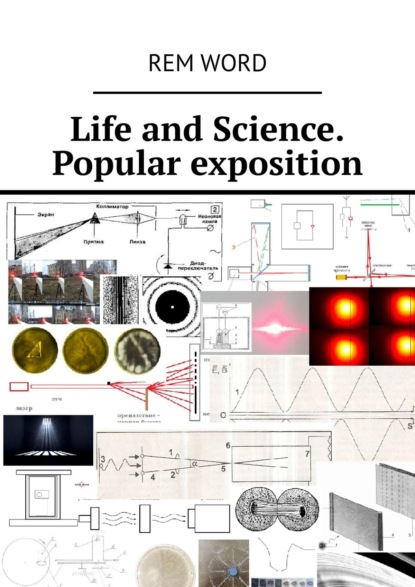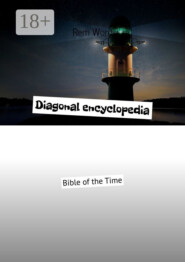По всем вопросам обращайтесь на: info@litportal.ru
(©) 2003-2024.
✖
Life and Science. Popular exposition
Настройки чтения
Размер шрифта
Высота строк
Поля
The first experience is the clearest. He delights the soul of the experimenter very much. The second one is so-so, but it is also good. The third is practically nothing. Fourth, we begin to worry, rush, and reproach ourselves for imaginary negligence. But that’s all right. The more one experiment is similar to another, the more they are related. It does not even matter whether such an attitude existed in the past or exists now. In general, the pileup of “souls” of the same experiences in one place smears the results in the present time. The law of extinction of reactions is only a particular manifestation of a much more interesting and extensive System of interaction of similarities in Space of Time.
Simple in the present. Inseparable continuum
“And there is no more time”
A series of repetitive reactions according to the same scenario tends to fade away. These reactions include almost everything – from interactions of atoms to biological cycles. The first result is maximum, decline, rise, decline – and a plateau of monotonous low-intensity reactions. The past affects the present. Action is aimed at blurring the results of the next similar Phenomenon.
Are you yawning already? Then a short spoiler. What is the meaning of research?
…If we unravel the mechanism of this action, then… We will be able to see the Past itself. Time, in its entirety… Or even materialize the necessary fragments of it. Modeled after the present. A pleasant bonus is the victory over aging.
Do you know what the Pauli principle is? We open our beloved Wikipedia. “Pauli’s principle can be formulated as follows: within one quantum system in a given quantum state there can be only one fermion, and the state of the other must differ by at least one quantum number.” Fermion is all atoms of the periodic table. In addition to helium, and even then, at temperatures around absolute zero.
The Pauli Prohibition principle in human language sounds like this. In one atom there should not be two completely identical particles, in one molecule, in a cluster (speck of dust) … The dimensions of a “quantum system” are simply not defined by physics textbooks. The mechanism of repulsion, or even rejection of complete mutual similarities is not considered. So it is, that’s all. Leave me alone. Let’s not go into details…
Two separate identical macroscopic objects also have the same set of energetically identical microparticles. Is it okay that I used the same words in one phrase? This is prohibited by the rules of the literary language. Each atom of, say, our galvanized plate can be opposed to a “forbidden” atom from another plate. Inside them, there are initially no completely identical microparticles.
What happens if you connect two identical material objects visible to the eye? Explosion? Annihilation? Warm, but not quite. Let’s postpone this question for another time. Now let’s try to reverse the Pauli exclusion principle along the vertical. In quantum mechanics, not that is allowed. So, in our opinion, it is forbidden to find identical objects not only in one small area of space, but also in time. It is possible to show some dissatisfaction of the Space of Time with the repetition of the past, for example, if one reproduces the same reactions without leaving the place. Chemical or biological, not much difference. The past suppresses the present according to the schedule you already know:
Decay graph of reactions
Did you understand? By performing a physicochemical experiment, we can find out for sure whether a similar experiment was put here before. A certain complication of the research scheme makes it possible to determine some of the distinctive features of the object that was in a given place.
This is a victory over Time
I don’t quite understand what this picture means, but let it be an illustration. The past in the present
The past is in the present. Or – zero speed of light
Speed of light and memory of place. How is this interconnected?
In addition to the modernized Pauli principle, there is another variant of the development of ideas about the mechanisms of memorizing the Universe of the events that took place in it. Perhaps they are the same thing, only a side view
…The paradox, dear friends, is that the speed of light is constant and non-constant at the same time. How can this be?
Our eye sees predominantly in a narrow yellow-green spectrum. A certain length of light waves. Infrared range. Ultraviolet – no longer. We know this and do not complex about it. Our capabilities are complemented by special devices.
And this does not mean at all that light with wavelengths greater or less than the yellow-green part of the spectrum does not exist.
Postulates of the Theory of Relativity. They are known in all languages of the world. Let us draw the red forbidding line
The same is true for the speed of light. Here, not only the eye, but also most of the known devices cannot “see” light, the speed of which differs from the standard value “C”, three hundred thousand kilometers per second. Particles of light, photons, they are sometimes waves, pass through them unnoticed. Energy levels do not match. All this correlates perfectly with the well-known laws of physics. This state of affairs is illustrated by the almost everyday Mössbauer effect.
…By and large, the constancy of the speed of light is very necessary for quantum mechanics. Without it, Maxwell’s basic equations simply refuse to work. But this decision may well resolve the paradox and allow one to move towards new horizons.
Thermal imagers, X-ray machines, and other devices that operate with beams of different frequencies are useful and important. Well, is that all? Imagine now that we are entering a fundamentally new line of devices that allow you to see “fast” or “slow” non-standard light. That’s quite possible. You just need to know how.
And what will we see?
Frozen near objects, light clouds emitted by them. Light with a speed of zero, or near-zero relative to the atoms that emitted them. Reflective body structure. Weak, specific, but affecting rough matter. And I, dear friends, will once again allow myself to use a tempting picture. A vision of an ancient sailing ship on the site of a dry sea. Who Said Science and Feelings Can’t Be Together? Like two equal wings of a bird…
Without words… And with words. According to some assumptions, “slow” light sensors are capable of registering past events. Light matter accumulates in places of events, like clouds. Information casts can be seen. Slow light, with a speed of zero or near-zero relative to material objects, is very interesting. These “clouds” migrate and are quite capable of settling in objects similar to those already destroyed. They strive to restore them to their previous model. As if you know, souls.
We continue without a break.
According to Einstein’s postulate, the speed of light is constant. It doesn’t matter if a cyclist has a flashlight, as shown in the pictures illustrating the Special Theory of Relativity (SRT), on board an airplane or a starship. No matter how you measure, you will get the same 300 thousand kilometers per second. The wavelength will change, you can say the intensity of the light. But not speed.
Question: who checked it? There are space observations. The images of stars revolving around their axis, floating in the abyss of space, are not blurred, which means that light has the same speed. Otherwise, the “slow” and “fast” light from parts of the stars with different speeds, instead of a shining point, would show something like a comet.
But Cosmos is Cosmos. And you prove something within the terrestrial laboratory. The Italians of the OPERA group in Gran Sasso have already shown that something is not good with the theory of relativity. Lightweight neutrinos easily exceed the speed of light.
Italy. Done and Forgotten. The main point: the neutrinos generated by the reactor are flying too fast. Faster than light
Russia. Ridiculous experiment on good equipment. It is possible to measure the speed of light “pushed” by the emitting particles directly using high-speed oscilloscopes. Russian scientists don’t
Here’s another experiment. It was held in Russia. The results are presented by the journal “Science and Life”, No. 8, 2011. Already something, in my opinion, is close to the truth. But, not really. Here is a particle accelerator. The particles spin at tremendous speeds (in one direction only) and emit light as they move. This accelerated light is diverted into a special window and… what do you think? Is its speed measured directly? This is quite possible in this experiment. Not at all. Experimenters introduce a glass plate into the path of the beam, and thus prove that the speed of light does not change when passing through a screen (analogue of ether?).
For what? Everything is much simpler.
Long before that, the author was involved in measuring the speed of light, “pushed” by microparticles. Normal white light bulb. There are those in your work. Ions rush in it at a speed that can be compared with light. With the help of a diode, we make the particles fly in one direction of the tube, then in the other. I don’t have superfast sensors and high-speed oscilloscopes. Therefore, we simply project the image of the lamp onto the screen using a pinhole camera (a hole in the shield). If the quanta have a longitudinal velocity component, the image should shift. And so it happens.
This experiment, in contrast to the experiment with the synchrophasotron, you can repeat yourself
For those who love details. Based on the articles of the author in the journal “Tekhnika-Molodezhi”, No. 10, 2001, and No. 3, 2002.
“… In a household fluorescent lamp, the plasma temperature is on the order of tens of thousands of degrees. This corresponds to the motion of charged particles with a speed of about 1000 km / s. The photons emitted by ions flying with a speed V must have a speed C + V directed along the axis of the lamp parallel to the screen, in accordance with the classical principle of adding speeds, and not with the SRT formulas. If so, the spot will move in the direction of the movement of the ions emitting light. If the second postulate of SRT is true, there will be no displacement. I am using a neon lamp with a glass shell that is transparent to UV radiation. The light from the emitter passes through a narrow diaphragm and hits a screen located parallel to the plane of the emitter electrodes at a distance of 0.8 m. The direction of the current can be changed using a diode. An image of a lamp appears on the screen… When the direction of the current changes, it shifts in the direction of ion movement by 11 mm. This means that the speed of light C is added to the speed of movement of the source V according to the “ballistic” principle. According to indirect estimates, the ion velocity is 2000 km / s. This is in good agreement with the experimental results. Therefore, either the second postulate of SRT is incorrect, or its meaning needs special clarification.
Home laboratory instrumentation – mercury and neon lamps instead of synchrophasotron
Experience with polarity reversal and prism
As they say, to seek is to seek, and therefore I set up a second experiment with a neon lamp, changing the conditions. The main element is now a prism that deflects light rays of different wavelengths in different ways. If the speed of light is greater than C, the spectrum shifts towards the violet side. If less than C, a “redshift” occurs, as when observing a receding radiation source. And this is not the Hubble effect. I place the neon lamp so that the plane of the electrodes is perpendicular to the pinhole screen. When the lamp is turned on, a spot of light appears on the screen. After polarity reversal, the beam is shifted by 24 arc minutes. Using the well-known formulas, we calculate that in this case the change in the speed of light is 520 km / s, with an error of 85 km / s.
I draw your attention to the fact that the change in the refractive index of the prism due to the different speed of the photons in the ray incident on the glass is usually masked by the property of the refractive medium. The refractive index, precisely because of the differences in the speed of quanta in vacuum (air), depends little on color, and is abnormally large. This experience is based on rather subtle assumptions, and does not have sufficient clarity. It would be more correct to use two low-inertia photosensors placed along the pulsating beam and connected to high-speed oscilloscopes. Reversing the polarity of the lamp would reveal the whole truth, which of the rays flies faster. Once and for all. The author does not have such tools.
Search for ether. Search everything
Michelson-Morley interferometer. 1. Light source 2. Screen for observing the interference pattern. 3. Beam reflected perpendicular to the interferometer arm and deflected by the ether flow to the left. 4. A ray emitted towards the stream of ether and therefore participates in the construction of an interference picture. 5. Beam reflected from the mirror of the interferometer arm, presumably directed along the ether stream. Figure above. Author’s experience with laser beam deflection. 1. Laser. 2. Laser beam at 9 am. 3. Beam at 17 o’clock. The angle is increased for clarity. 4. Place the mark on the screen at 9 o’clock. 5. Mark at 17 o’clock. The screen and the laser are separated by 90 m. The difference in the position of the beam on the screen, over five days, is 3 cm.
…Does ether exist, this kind of ocean in which light waves roll? And, as we assume, keeping the shadows of the past quite fresh, forever? Let’s bring a revision of physics. Michelson-Morley interferometer. The beam is divided by a translucent mirror. One of them goes towards the stream of ether, then back. Its speed changes. The second is perpendicular to the flow and therefore serves as a standard of speed. If the speeds do not match, the interference pattern will change. In the figure below on the left, the author imagines that the position that the rays pass strictly perpendicular paths is incorrect. During the stroke along the arms of the interferometer, the rays are deflected by the ether stream. The detector receives waves initially deflected towards the ether stream. The scheme for constructing a real interference pattern is much more complicated than Michelson’s drawings. In addition, according to the reasoning about the Mössbauer effect, only light with a “standard C” speed of 300,000 km is clearly observed. from. Figure above the interferometer. The author’s experience. The deflection of the laser beam, presumably due to entrainment by the ether. If the ether is carried away by light, with the specified parameters, the flow velocity of the medium is 100 km. from. This value is in good agreement with the speed of the Earth’s revolution around the center of the Galaxy, 200—220 km. with.. Why didn’t you notice earlier? When operating laser communication systems, the system is “zeroed” automatically or manually. This rule is considered the norm. A more plausible explanation. During the day, the air in the room where the experiments are carried out warms up. The air lens distorts the beam.
An Interferometer for the Poor. And it’s not even an interferometer
…Several years later, I decide to repeat this experience. The deviation of the beam obtained in the preliminary sample is large enough to try to create an “interferometer for the poor”, with the ability to change the direction of scanning the ether manually. On a massive bar, parallel mirrors and a laser sight are placed. The length of the beam reflected twice is 6.5 meters. It is inconvenient to turn the device and observe the change in the position of the beam at the same time. To record the results, an electronic camera rigidly fixed on a bar (not shown) is used.
…First, we reproduce a stationary experiment. We send the beam not to the lens, but to the laboratory wall. This increases the length of the light path to 10 meters. It all fits together. After 5 hours, the light spot shows a new position, 4 millimeters below. It is alarming that after a day, that is, the Earth’s rotation around the axis, it does not return to its original mark.
We pass to independent turns of the “interferometer”, without the help of the planet.







